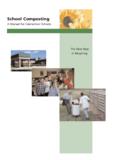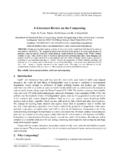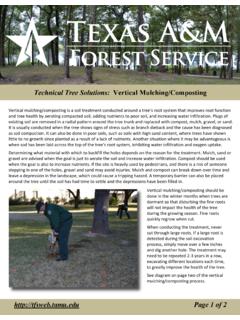Transcription of BARREL COMPOSTING MADE EASY - Glen Allen …
1 BARREL COMPOSTING made easy Collect and prepare the material*: Gather together enough "brown" and "green" material to fill your composter all at once. Using the 70/30 rule, by weight, use approximately 70% brown and 30% green material. For ideal COMPOSTING results, prepare the material so the particles are approximately 1/2" to 2" inches or less in size. Cutting up or shredding material increases the surface area of the material thereby increasing the speed of COMPOSTING . For dry leaves and small yard clippings and trimmings, try laying them out on the lawn and run over them a few times with a lawn mower. For some of the larger items, consider getting a small yard chipper to run them through first. The smaller the partial size, the faster it will compost. Filling the your Composter: It helps to start by leaving a little compost (seasoning) in the BARREL from the time before. Begin putting in equal amounts (by weight) of "brown" and "green" material.
2 About every 5" to 8" you may want to add a handful of a natural compost starter and then dampen if needed. If you are using over 25% fresh grass or vegetable scraps, you probably will not need to add water. If 30% or more of your material is fresh cut grass, consider letting the grass dry a couple days before putting in the unit to avoid excess water build-up. When you add water, if possible avoid using chemically treated water ( municipal water) but instead use natural rainwater. Your mix should be damp as a wrung out sponge. It should feel wet but you should not be able to squeeze out water. When it s humid outside, avoid adding any water. Being an enclosed unit, water will collect inside the unit from humidity. It is important to avoid packing the material down too much, as it will impede mixing when the unit is tumbled. It is IMPORTANT to leave a little empty room in the BARREL to allow mixing. Also remember that a full BARREL will turn easier than when half full.
3 While not required, you will get the best results by gathering up enough varied material and loading the Composter all at the same time Batch COMPOSTING is the most efficient as it allows for rapid heat build up all at once. It is ok to add material to the Composter as it becomes available, be aware if you do, the overall COMPOSTING time will take much longer and you will not get the same concentrated heating of the compost batch if you add the material too slowly. Also, continuing to add material to the Composter can be deceptive since the volume of COMPOSTING materials can drop rapidly. COMPOSTING Once the unit is filled, screw on the lid (be sure the aeration holes are (open/clear) and let it sit. At lease weekly, rotate the tumbler 2 or 3 times in each direction - daily rotation is even better. Remember that oxygen is the key to rapid COMPOSTING . Especially during the first week or so, check to be sure that the material was not packed so tight that it is not mixing when tumbled.)
4 If the material can't move around enough to allow fresh oxygen into the mix, COMPOSTING will be slower. Remember to keep an eye on moisture content. If the material becomes too dry, add water. If it becomes too wet, remove the lid until it dries some. Having two or more Composters works even better. In effect, you double your capacity with two units and cut your COMPOSTING time in half. Two units allow you to either load twice as much at one time if you have a lot of material, or to load a unit every 1-2 weeks to have a more even flow of finished compost ready for use. ADDING SUPPLEMENTS TO YOUR COMPOST There are good reasons to consider adding supplements to your compost. The nutrients added to compost are then added to the soil where you put the compost. For example, we recommend using only all natural organic supplements like a Compost Activator. An activator speeds COMPOSTING while adding nitrogen, phosphorous and potassium to the finished product.
5 Add Prilled Dolomite Lime to the mix to "sweeten" soil when too acidic. Most plants grow best when the soil pH is between and Dolomite Lime is a good source of calcium and magnesium, two important plant nutrients. POINTERS & CAUTIONS IN USING YOUR COMPOSTER Set up It is VERY important that the Composter be setup on a level firm footing. If the unit is sitting with a tilt it can become unstable when rotated. If set on the ground or lawn, be sure it is level, firm and dry. If set on a deck, patio, concrete floor, decorative blocks, or similar material, consider using a "drip pan" beneath the unit to catch occasional drips. One suggestion is setting the Composter on firmly positioned patio stones or concrete blocks. Loading the Composter The principle behind the Composter is to fill it all at once and produce a compost batch empty and repeat the process. A lot of small batches faster is the key to effectively using just about any tumbling composter.
6 The Composter can do batches gathered over time but it will take much longer to compost. Usually a 70/30 load of brown and green material does not weigh that much, however when adding large amounts of water, vegetables/fruits, green manure and the like, be careful not to overload the Composter. While a little additional weight may not hurt the Composter, it will become more difficult to turn for some people. Tumbling/Rotating the Composter Care must be taken when rotating (tumbling) the BARREL to avoid possible personal injury or damage to the unit. To rotate, stand to one side and begin "rocking" the BARREL back and forth a couple times to build momentum. Then as the BARREL swings forward, using the force of the momentum of the BARREL , "push down" to complete the rotation. It is important you push down on the BARREL and NOT outward or sideways. Pushing outward may cause the unit to tip over and lateral (sideways) movement may cause damage to the stand.
7 The Composter is easier to turn when full rather than when just partially filled. The BARREL turns around the center shaft so the more weight you have on both sides of the shaft (top vs. bottom), the more "in balance" the BARREL is. However, you do not want to fill the BARREL to the very top as you need some space to allow for mixing. Remember after tumbling to be sure the aeration holes are open/clear. Break-in Period Breaking-in or burning-in your Composter is important. The first couple batches of compost produced by the BARREL usually takes a little longer than normal and is of lower quality compost. It seems to take at least a couple good batches of compost to season the BARREL . It is a good idea that in your first few compost batches you liberally use a good quality all natural compost starter. Excess Moisture in the Composter Several things can cause excess moisture in the BARREL . It means either too much water has been added or too much green material (fresh grass, vegetables or fruit) was in the mix.
8 If you keep getting too much moisture in the mix, you must change your recipe to use more brown (carbon rich) material and avoid adding water. In some humid areas excess moisture can build up in the BARREL as the temperature varies between night and day. If the compost becomes too moist, remove the lid until it dries out some. To speed drying, replace the lid periodically and tumble the unit to keep wet compost exposed. Let the BARREL rest at an angle to expose as much compost as possible. When the lid is on, remember to keep the vent holes at the top of the BARREL clear to allow air circulation. * COMPOSTING MATERIALS B r o w n Brown is the carbon energy the compost microbes need to thrive. Without it, your pile of green kitchen scraps will become smelly and slimy. This is because your greens will decompose too quickly through the bacteria already in the materials, rapidly fermenting nitrogen into the rotten egg smell of ammonia.
9 You want enough brown materials for the good bacteria and microbes to have enough energy to multiply and slow down the release of nitrogen. The layering effect of compost is a natural way to do this. If your compost has a rotten rather than rich, earthy smell, add some more brown materials to the mix. Stir it as well, as a lack of oxygen also contributes to unpleasant smells. Brown materials are stocky and coarse, and include: x dry yellow or brown leaves and grass x the woody stalks of plants such as sunflowers and corn x paper and wood products, such as sawdust, chopped up twigs and shredded newspaper x dryer lint x straw x wood ash (not too much) Green Materials Nitrogen is the protein the munching microbes need to thrive. Too little nitrogen and your pile will decay into compost a lot more slowly. The microbes will be fewer and weaker, so it could take a year or two in a mainly brown compost pile to turn into rich compost.
10 A well-balanced compost will be hot, due to all those microscopic bodies busily multiplying and feasting for you! Green materials are soft and often wet, and include: x Kitchen scraps, such as vegetables, melon rinds, eggshells and fruit x coffee grinds with the filter and tea bags x fresh green leaves and grass clippings x fresh weeds that haven t seeded (seeds will likely survive the COMPOSTING process) x composted manure cow, sheep, chicken, rabbit x hair scatter the hair in the bin, not in clumps







